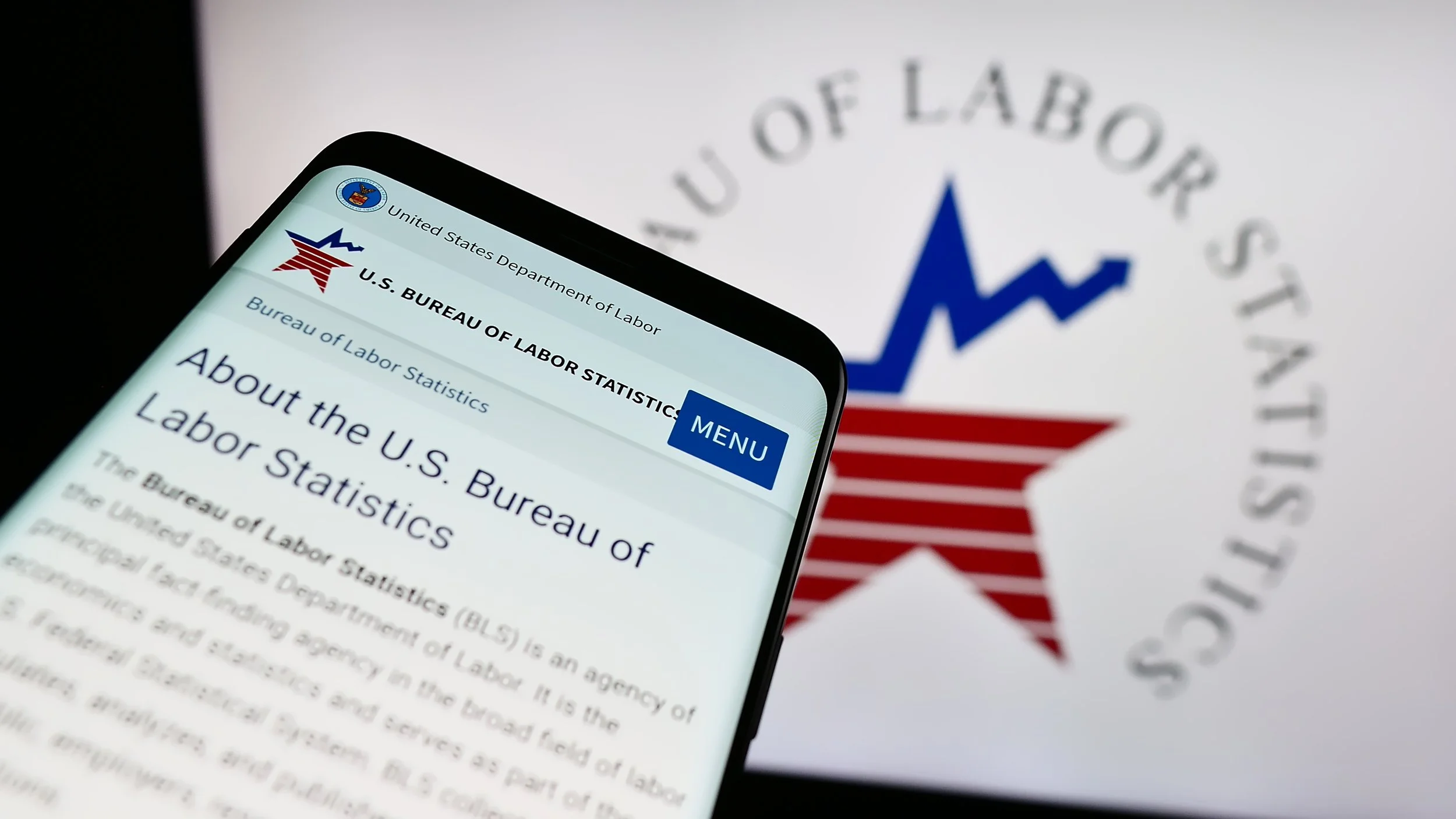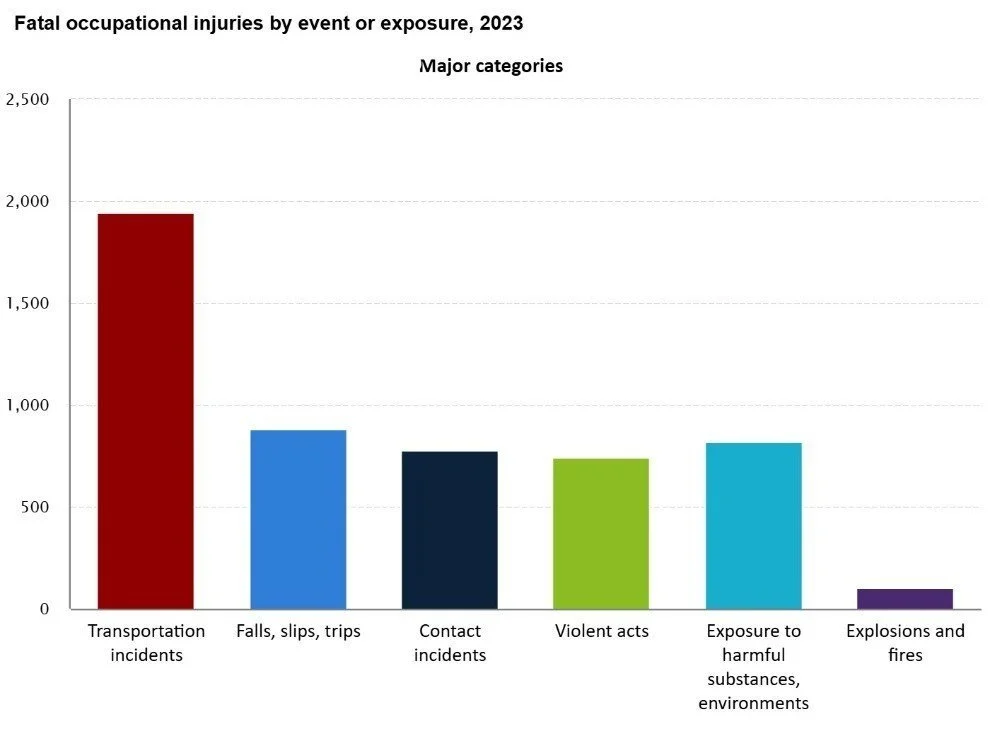
Industry News

US Bureau of Labor Statistics Updates Fatal Work Injuries Data
Author, Jadyn Brandt, Client Communications Coordinator, Rancho Mesa Insurance Services, Inc.
The U.S. Bureau of Labor Statistics has released their Census of Fatal Occupational Injuries Summary for 2023. This data highlights important safety trends across multiple industries and demographics, and can be helpful in determining what areas an employer should look to emphasize in their safety program.
Author, Jadyn Brandt, Client Communications Coordinator, Rancho Mesa Insurance Services, Inc.
The U.S. Bureau of Labor Statistics has released their Census of Fatal Occupational Injuries Summary for 2023. This data highlights important safety trends across multiple industries and demographics, and can be helpful in determining what areas an employer should look to emphasize in their safety program.
According to the report, a total of 5,283 fatal work injuries were recorded in the United States in 2023; a 3.7% decrease from 2022. The report shared several key findings, which include:
1,942 occupational fatalities—or 36.8% of all deaths—were caused by transportation incidents.
740 fatalities were caused by violent acts, with the majority resulting from homicides.
Opioids were found to be the source of 162 fatalities, and a contributor in an additional 144 drug-related fatalities.
Additionally, the report breaks down the annual fatalities by occupation and industry.
Since 2011, the construction industry has recorded the highest annual number of fatalities among all industry sectors and 2023 was no different. 1,075 construction deaths occurred in 2023. Slips, trips and falls were the most common types of fatalities, accounting for 39.2 percent (421) of all construction fatalities, followed by transportation incidents which accounted for 22.3 percent (240) of fatalities.
Source: U.S. Bureau of Labor Statistics
Human services organizations recorded significantly less workplace fatalities than the construction industry. However, the total number of fatalities within these types of human services organizations didn’t change from 2022 to 2023 with a total of 178 fatalities occurring in both years. Transportation incidents accounted for 37.6 percent (67) of fatalities within human services organizations, while violent acts were 16.3 percent (29) and falls, slips and trips were 13.5 percent (24) of fatalities.
Administrative and waste management and remediation services saw a total of 484 fatalities in 2023. Within that sector, the landscaping and grounds keeping occupation had the most fatalities (102), followed by tree trimmers and pruners (80). The report lists trees, logs, and limbs as the primary source of these deaths.
The risk of occupational fatalities can be mitigated through proper safety training and preparation. Rancho Mesa has a variety of training tools available for use across multiple industries which can be accessed through the SafetyOne™ platform, including driver training, slip, trip and fall safety, fall protection and workplace violence prevention training.
For more information about all the safety tools Rancho Mesa has to offer, contact your Client Technology Coordinator.
Strategies Employers Can Use to Combat the Coronavirus
Author, Jeremy Hoolihan, Account Executive, Rancho Mesa Insurance Services, Inc.
According to the U.S. Center for Disease Control and Prevention (CDC), there is no evidence of widespread transmissions of COVID-19 (commonly known as Coronavirus) in the United States, at this time. But, business owners should ask themselves, would my company be prepared in the event of an outbreak? Employers should be ready to implement strategies to protect their workforce while ensuring some semblance of business operations. The CDC has recommended the following strategies that employers can use, today.
Author, Jeremy Hoolihan, Account Executive, Rancho Mesa Insurance Services, Inc.
According to the U.S. Center for Disease Control and Prevention (CDC) there is no evidence of widespread transmissions of COVID-19 (commonly known as Coronavirus) in the United States, at this time. For the general American public, such as workers in non-healthcare settings, where it is unlikely that work tasks create an increased risk of exposure to COVID-19, the immediate health risk from the virus is considered low. Business owners should ask themselves, would my company be prepared in the event of an outbreak? The CDC recommends creating an Infectious Disease Outbreak Response Plan.
Employers should be ready to implement strategies to protect their workforce in the event of an outbreak of COVID-19 while ensuring some semblance of business operations. The CDC has recommended the following strategies that employers can use, today.
Actively encourage sick employees to stay home.
Employees who have symptoms of acute respiratory illness are recommended to stay home and not come back to work until they are free of a fever (100.4° or greater) without the use of fever reducing medicines. Employees should notify their supervisor and stay home if they are sick.
Ensure that your sick leave policies are flexible and consistent with public health guidelines and that employees are aware of these policies.
If your business utilizes contract of temporary employees, make sure the company you work with implements the same strategies as your business and recommends sick employees stay home.
Separate sick employees:
The CDC recommends that employees who appear to have acute respiratory illness symptoms (i.e. cough, shortness of breath) upon arrival to work or become sick during the day should be separated from other employees and be sent home immediately. Sick employees should cover their noses and mouths with a tissue when coughing or sneezing.
Emphasize staying home when sick, respiratory etiquette and hand hygiene by all employees:
Place posters that encourage staying home when sick, cough and sneezing etiquette, and hand hygiene at the entrance to your workplace and in other workplace areas where they are likely seen.
Provide tissue and no-touch disposal receptacles for use by employees.
Provide and encourage the use of alcohol-based hand sanitizer that contains at least 60-95% alcohol, or wash hands with soap and water for at least 20 seconds.
Perform routine environmental cleaning:
Routinely clean all frequently touched surfaces in the workplace, such as workstations, countertops, and doorknobs.
Provide disposable wipes so that commonly used surfaces can be wiped down by employees before each use.
Advise employees before traveling to take certain precautions:
Check the CDC’s Traveler’s Health Notices for the latest guidelines and recommendations for each country to which you will travel.
Advise employees to check themselves for symptoms of acute respiratory illness before starting travel and notify their supervisor and stay home, if they are sick.
Ensure employees who become sick while traveling or on temporary assignment understand that they should notify their supervisor and promptly call a healthcare provider for advice, if needed.
Additional measures in response to currently occurring sporadic importations of the COVID-19:
Employees who are well but who have a sick family member at home with COVID-19 should notify their supervisor and refer to CDC guidance for how to conduct a risk assessment of their potential exposure.
If an employee is confirmed to have the COVID-19 infection, employers should notify fellow employees of their possible exposure to COVID-19 in the workplace but maintain confidentiality as required by the Americans with Disabilities Act (ADA). Employees exposed to a co-worker with confirmed COVID-19 should refer to CDC guidance for how to conduct a risk assessment of their potential exposure.
Engage state and local health departments to confirm channels of communication and methods for dissemination of local outbreak information.
It is extremely important for business owners to know what they can do to minimize the spread of an infectious disease. It is equally as important to be prepared for an outbreak (whether it’s COVID-19 or any other potential infectious disease). Having an Infectious Disease Outbreak Response Plan can guide a business during these trying times. Rancho Mesa Insurance’s RM365 HR Advantage™ online portal offers instructions on “How to Handle an Infectious Disease Outbreak.” If you have any questions relating to this subject matter please feel free to reach out to Rancho Mesa Insurance.
Promoting Safe Behaviors in the Workplace
Author, Jeremy Hoolihan, Account Executive, Rancho Mesa Insurance Services, Inc.
Safety awareness is one of the most important factors in reducing workplace injuries. There are approximately three million workplace injuries, every year. This amounts to roughly 8,000 injuries per day, 350 per hour, or 6 injuries per minute. Many of these injuries are preventable. Unsafe behaviors or decisions are usually the most common contributing factors. If employees are unaware of hazards or not motivated to follow safety protocol, their behavior will expose them even more.
Author, Jeremy Hoolihan, Account Executive, Rancho Mesa Insurance Services, Inc.
Safety awareness is one of the most important factors in reducing workplace injuries. There are approximately three million workplace injuries, every year. This amounts to roughly 8,000 injuries per day, 350 per hour, or 6 injuries per minute. Many of these injuries are preventable. Unsafe behaviors or decisions are usually the most common contributing factors. If employees are unaware of hazards or not motivated to follow safety protocol, their behavior will expose them even more.
Promoting safe behavior in the workplace can be one of the most impactful ways of reducing injuries. I encourage business owners to go above and beyond the required controls and measures such as engineering, administrative, and personal protective equipment (PPE) and promote safe behaviors and a safe work environment. Below are examples of ways ownership and management can promote safe behaviors.
Conduct frequent safety meetings with employees and encourage participation. Discuss previous injuries or near misses with your employees to identify the root cause and any corrective actions that are necessary. Be aware that not all corrective actions are readily accepted by employees, especially those seasoned employees that are set in their ways. It is important to listen to their concerns, analyze and modify the procedure or task so that the employee will buy into the changes and not be tempted to break the rules and work unsafely.
Give recognition to employees who are performing tasks safely and demonstrate proper behaviors. A little bit of recognition amongst your peers can be extremely influential and can further promote safety in the workplace.
Involve the employees in identifying and correcting hazards in the workplace. This can promote self-worth in an employee. Your employees are your eyes and ears in the field and they may identify an overlooked workplace hazard. It is especially impactful when the corrective action was a hazard they identified on their own.
Perform safety observations to encourage safe behaviors. While supervisory observations are important, business owners should also consider peer to peer safety observations. By collaborating with employees and involving them in the safety program, it will help them buy into any changes that are necessary further promoting workplace safety.
Having ownership and management consistently express their concerns for their employees well-being and safety is another way to promote safe behaviors. As a business owner, communicating to your employees that your main concern is their safety can drastically change the culture of a business. Reminding your employees that you want them to go home safely each day, goes a long way.
Promoting safe behaviors in the workplace starts with ownership and management, but is executed daily by the workforce. Providing sound policies and procedures relating to safety, along with a strong collaboration between ownership, management, and staff can drastically improve safety in the workplace and promote a safety culture.
Rancho Mesa Insurance Services, Inc. is a strong advocate for workplace safety. We like to take a risk management approach with our clients and prospects to develop a program that fits their needs. Please feel free to reach out to me, Jeremy Hoolihan, at (619) 937-0174 to see how Rancho Mesa can improve your risk profile.




